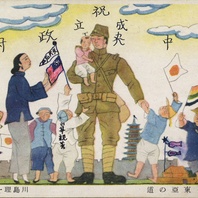
Item
Kagayaku Tōa no michi (The road to a shining East Asia)
This postcard, featuring an illustration by the prolific Japanese artist Riichiro Kawashima, shows a Japanese soldier celebrating “kagayaku Tōa no michi” (the road to a shining East Asia), with Chinese civilians. Of interest here is the fact that the Republican Chinese flag appears to have been drawn onto the postcard (and made to look as if it is being held by the child dressed in white), while other figures in the image hold the “five-coloured flag (wuseqi). The “five-coloured flag” was used by the Reformed Government of the Republic of China (RGROC) up until March 1940, but was replaced by the Republican Chinese flag with the formation of Wang Jingwei’s government. This suggests that the postcard was made prior to March 1940, but used some time thereafter. Text reading “qing zhu xin zhongyang zhengfu chengli” (Celebrating the founding of the new central government) has also been added above the figures, while the phrase “Ri-Hua qinshan” (Japanese-Chinese friendship) has been added to the boy in white.
Read More
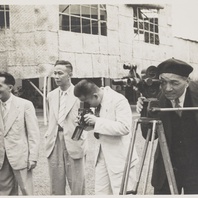
Item
Chu Minyi with film camera
The RNG foreign minister Chu Minyi tries his hand at filmmaking in this undated photograph. Next to him is (possibly) Chen Guoqi (a photographer for the RNG’s Central News Agency). The RNG Minister of Publicity, Mr Lin Baisheng, is on the far left of the image. This image was taken as Chu Minyi filmed a Cabinet meeting convened by Wang Jingwei in the summer of 1940. Newsreel footage of the event can be found here.
Read More
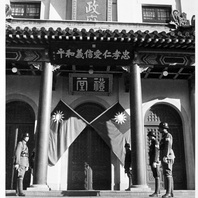
Item
Entrance to RNG Government Headquarters
Chinese and Japanese soldiers guard the entrance to the ceremonial hall (litang) of the national government compound in Nanjing in November 1940. Above the door is a plaque, written by the head of the (non-RNG) national government Lin Sen, which reads: “Loyalty, benevolence, righteousness and peace” (zhongxiao, ren’ai. xinyi, heping). Note that the “unadulterated” Nationalist Chinese flag (without the yellow pennant that the RNG had been forced to attach by the Japanese in spring 1940) is flown here.
Read More
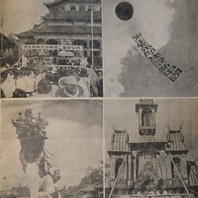
Item
Celebratory ceremony marking the second anniversary of Guangdong’s ‘rebirth’
This series of photographs is taken from Huanan huabao (South China graphic) 2.6 (1940), and shows celebrations to mark the second anniversary of what the Japanese referred to as the “rebirth” of Guangzhou (i.e., the fall of Guangzhou) in October 1938. Note the prominence given to the Sun Yat-sen Memorial Hall, as well as the use of “folk” forms of cultural expression.
Read More
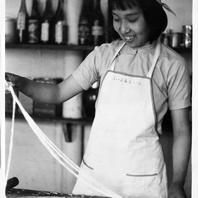
Item
Noodle cooking
From a collection of staged photographs produced under the title “Life at a Girls School in Peking”, and produced at the Peking Jiyu Gakuen in Japanese-occupied Beijing. The original caption reads: “A girl is pulling noodles according to a Chinese style instead of cutting smaller [sic]”.
Read More
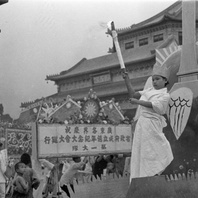
Item
Untitled (Boy dressed as angel of peace)
A boy is dressed as the “angel of peace” and rides on a float during celebrations marking the first anniversary of the founding of the Guangdong Provincial Government under Wang Jingwei in May 1941. The building in the background is the city’s Sun Yat-sen Memorial Hall (Zhongshan jiniantang).